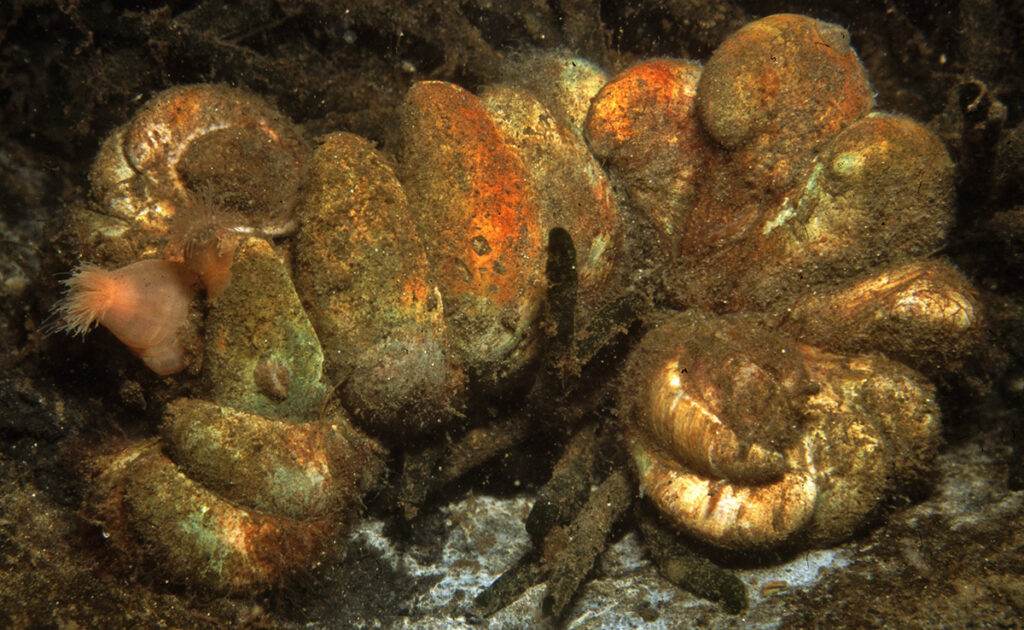
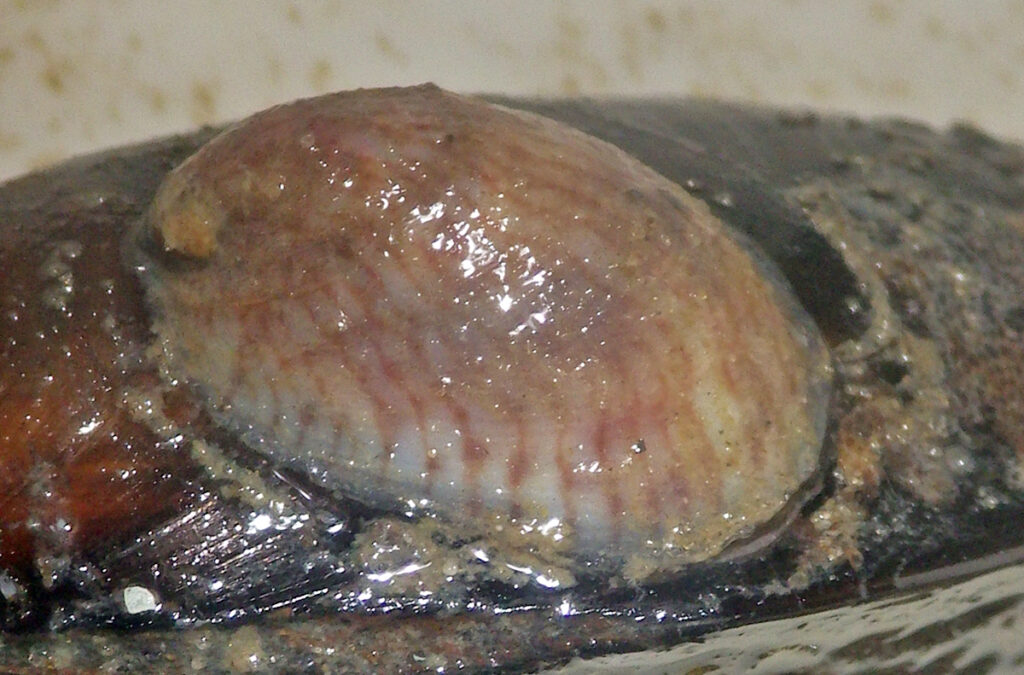
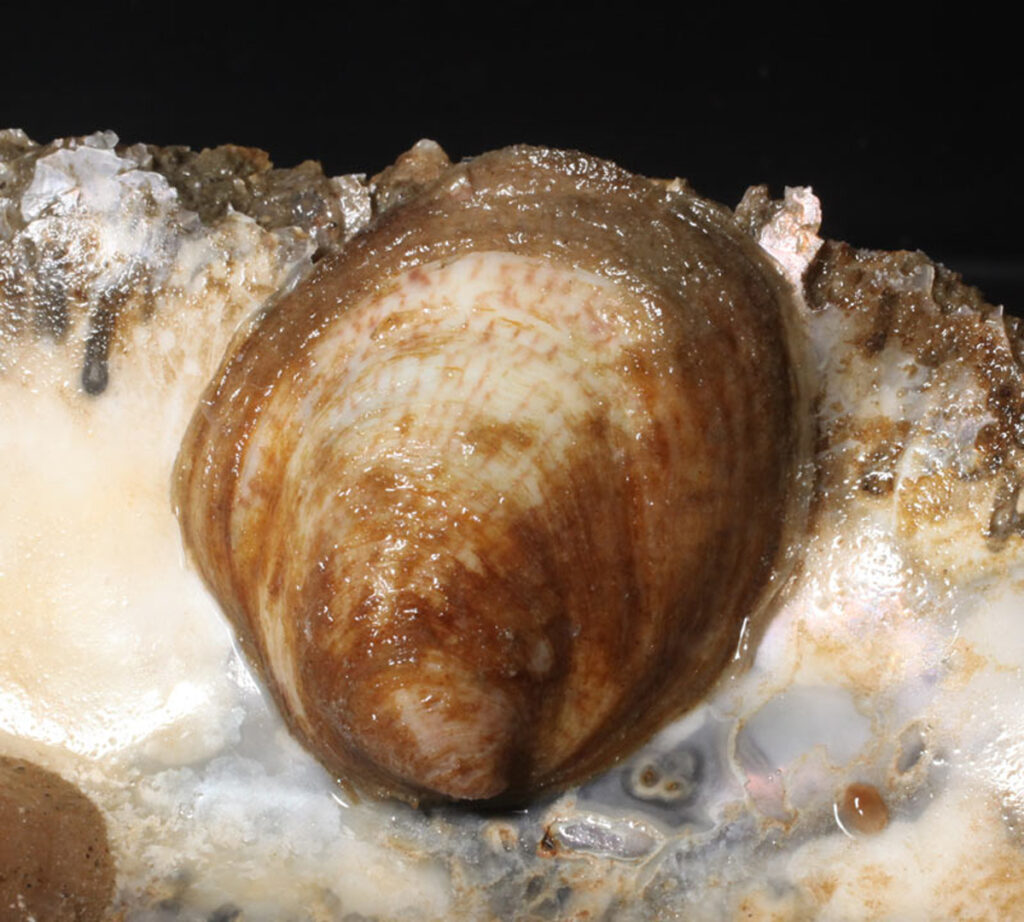
Slipper limpet
Crepidula fornicata
Also known as: American slipper limpet /slipper shell / oyster-pest
What does it look like?
This gastropod has slipper like shells that are strongly attached to the surface. Most individuals have a pattern of red stripes on a whitish shell although this pattern is not always easily visible. They are often found in piles on top of each other.
Distinguishing features
When looking from above, the somewhat downwards directed tip of the slipper limpet is positioned at the outer margin of the shell.
Confusion with similar species
Various limpet species occur along the western European coast. When looking from above, the tip of a shell of these other species tends to be positioned in or close to the centre of the shell, and not along the margin of the shell as is found in C. fornicata specimens. In addition, the tips of the shells of limpet like species are usually elevated instead of pointing somewhat downwards towards the substrate. The typical red striped pattern of the slipper limpet, if clearly visible, is also a good feature to distinguish Crepidula fornicata from native limpet-like species.
What is its origin?
Northwest Atlantic
Habitat
Crepidula fornicata is mainly found in the shallow subtidal on sandy bottoms with shells (e.g. oysters and mussels), pebbles and loose rocks until about 15 m of depth. Bays in which it becomes abundant lie somewhat sheltered from the open sea and thereby outside of the currents.
Presence in Ireland
Present on the Island of Ireland.
Behaviour and Spread
Each stack with American slipper limpets has one female that produces up to 20,000 free swimming pelagic larvae. These larvae have a pelagic phase of about three weeks until they settle on the bottom again. In addition to this natural dispersal method Crepidula fornicata specimens are probably mainly spread by hull fouling and shellfish transports.
Potential nuisance for aquaculture
Dense populations of Crepidula fornicata can become a nuisance for oyster farmers, as they have to clean their oysters. The most severe impact of dense C. fornicata populations is expected to concern the biodeposition of faeces and pseudo-faeces, whereby the total annual biodeposition is almost three times the total biomass. This will no doubt influence growth rates of oysters and mussels, or other commercially important shellfish. In lower densities the American slipper limpet is not expected to have a large impact on aquaculture. Positive impacts that have been described in literature include that its feeding activities may prevent blooms of harmful algae, and that the presence slipper limpets on mussels may decrease predation by starfish.
Key Management Actions
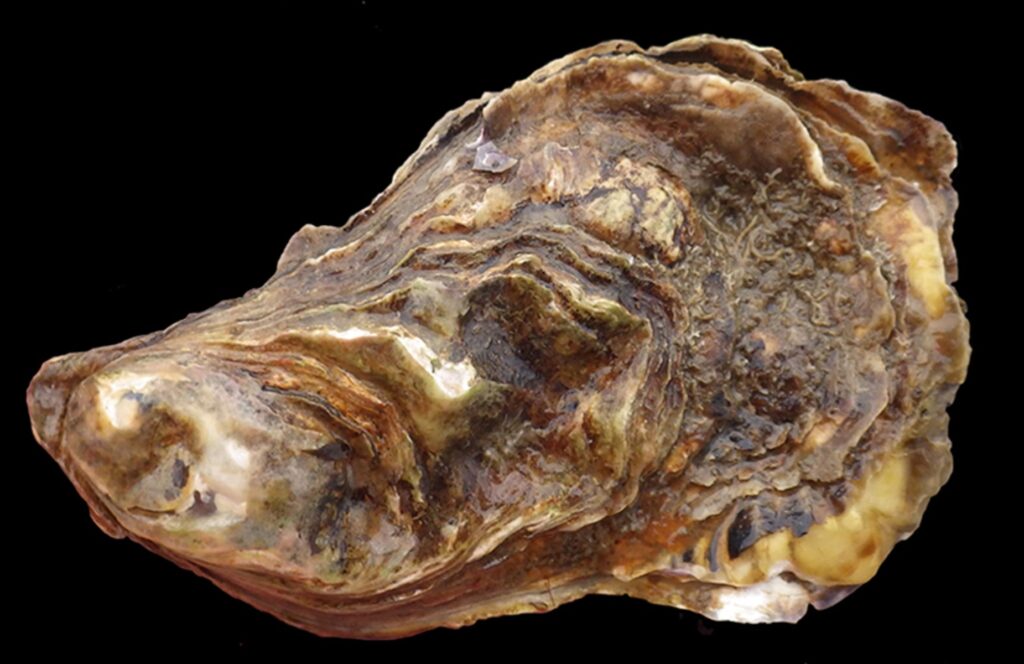
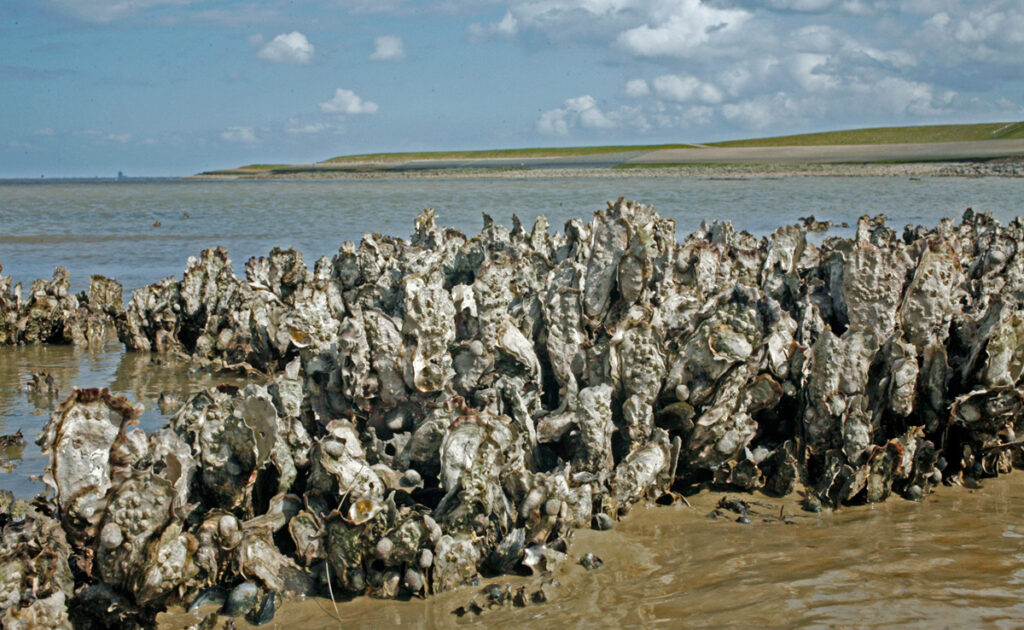
The Pacific oyster
Crassostrea gigas
Also known as: Japanese oyster, giant cupped oyster, Rock Oyster, Megallana gigas
What does it look like?
Crassostrea gigas is an oyster with an irregular elongated shape with strong ridges on both sides.
Distinguishing features
Pacific oyster shells can vary in their form. In general, a Pacific oyster has strong ribs and is longer than it is broad. It has two valves that are unequal in size and shape, one of which is relatively deep, and cup shaped.
Confusion with similar species
The Pacific oyster resembles the native flat oyster Ostrea edulis. A flat oyster tends to have a more circular shape when compared to the more elongated shell of C. gigas. Another distinguishing feature concerns the fact that O. edulis has one flattened side with minor ridges and ribs that could, to some degree, be peeled off by scraping with your fingernails. C. gigas shells tend to be much more irregularly formed, having strong ridges on both sides, which are difficult to damage when scraping over them with your nails.
What is its origin?
Northwest Atlantic
Habitat
The Pacific oyster C. gigas prefers to form reefs in the intertidal to shallow subtidal on hard substrata like rocks, and sometimes also on sandy flats. More rarely settled specimens can be found on floating objects like pontoons and ship hulls.
Presence in Ireland
Present on the Island of Ireland.
Behaviour and Spread
Spawning happens by releasing millions of eggs in the water column in late spring to early summer when water temperatures rise above ~16 ° Celsius. Subsequently, the larvae have a pelagic phase of about 2 to 4 weeks during which they are spread with the currents. In addition to this natural spread, anthropogenic vectors that may play a role in the distribution of this species concern shellfish transports and hull fouling. Although it is widely cultured in Ireland, it must be done so under licence and conditions predominantly stipulate the growing of hatchery sourced triploid seed.
Potential nuisance for aquaculture
Pacific oysters may be a nuisance to flat oyster fisheries, as they can locally outcompete the flat oyster for space. Areas where mussel beds may be formed, can become covered by Pacific oyster reefs. Fishing equipment, including nets, buoys and fishing vessels can get fouled by Pacific oysters, possibly damaging the equipment or making it harder to work with, as the shells can be razor sharp.
Key Management Actions
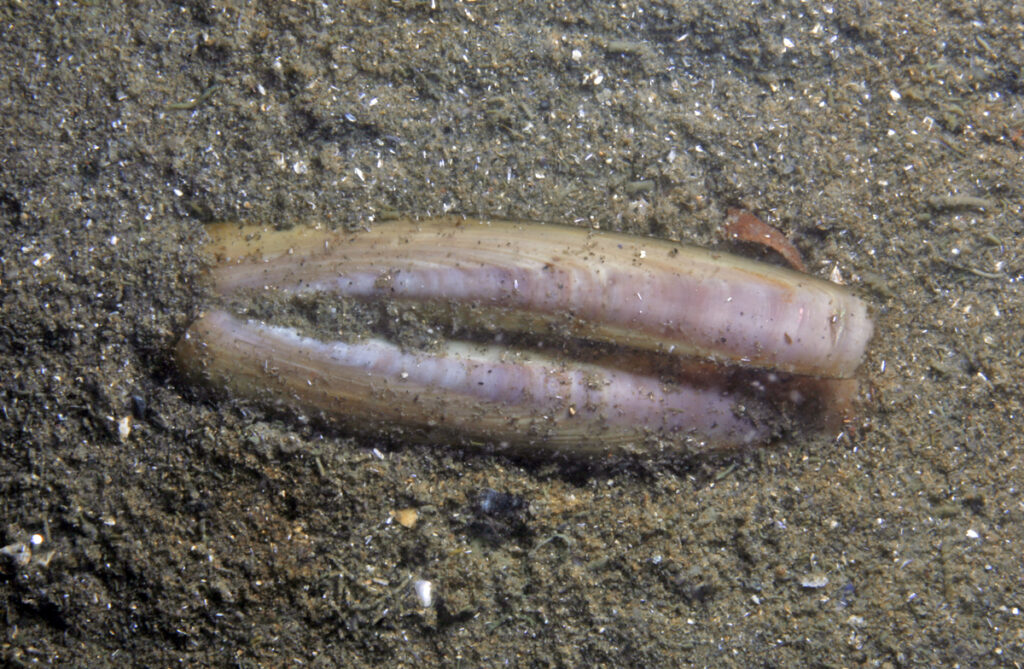
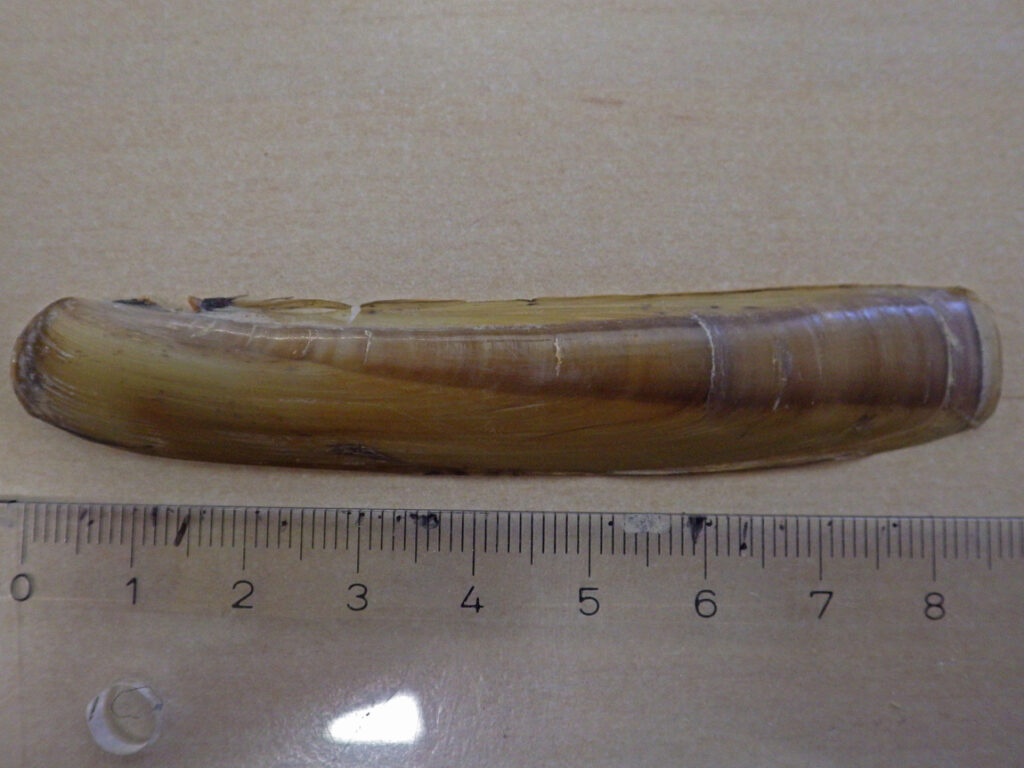
The American jack knife clam
Ensis leei
Also known as: Atlantic razor clam
What does it look like?
Ensis leei is a thin elongated bivalve, which can reach a shell length of 20 cm. The shells can be razor sharp.
Distinguishing features
Ensis leei specimens can be distinguished from native jack knife species by the bended form of the shells in combination with the marks left by the soft body and muscles on the inside of the shell (see figure).
Confusion with similar species
Ensis leei can be distinguished from the native jack knife clam species Solen marginatus and Ensis siliqua by the bended form of its shells. These two native species have straight shells.
This bend in the shells cannot be used to distinguish between E. leei from Ensis magnus which has slightly bended shells and the native Ensis ensis which has strongly bended shells. The best way to distinguish these species from each other are the patterns and relative lengths of the lines that are left by the animals’ soft body and muscles on the inside of the shell. For example, where the length of line B is about 1.5 times the length of A in Ensis leei , line B is at least two to three times as long as line A in Ensis ensis.
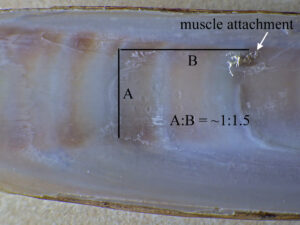 |
What is its origin?
Northwest Atlantic
Habitat
The American jack knife clam occurs in (muddy) sand bottoms in the lower intertidal and shallow subtidal zone.
Presence in Ireland
Present on the Island of Ireland.
Behaviour and Spread
American jack knife clams are broadcast spawners that release both eggs and sperm into the water where fertilisation takes place. Larval development takes place in the water column over a 2 to 3-week period during which the larvae are dispersed by residual water currents until settlement. Settling densities of more than 3000 individuals per square metre have been recorded.
As mussels and oysters live in different habitats, transports of mussels and oysters are unlikely to aid in the spread of this species. Especially in the past, with the absence of ballast water management, ships’ ballast water transports are assumed to have been the most important anthropogenic vector aiding the dispersal of this invasive species.
Potential nuisance for aquaculture
Because Ensis leei inhabits soft substratum habitats, it is not usually found within mussel or oyster culture areas and is therefore not a direct nuisance for these shellfish industries. When Ensis leei populations are dense (up to 3000 individuals per square meter), they may compete for food with other filter feeding shellfish in the region.
Key Management Actions
The dispersal of Ensis leei in Europe cannot now be stopped by any management action.
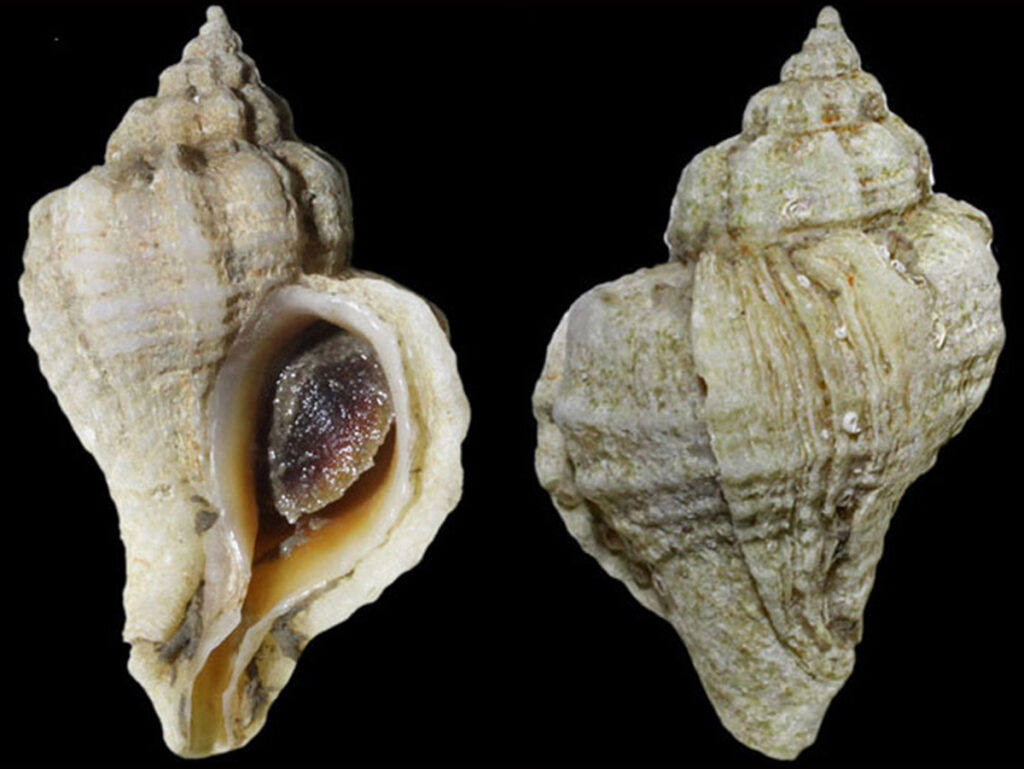
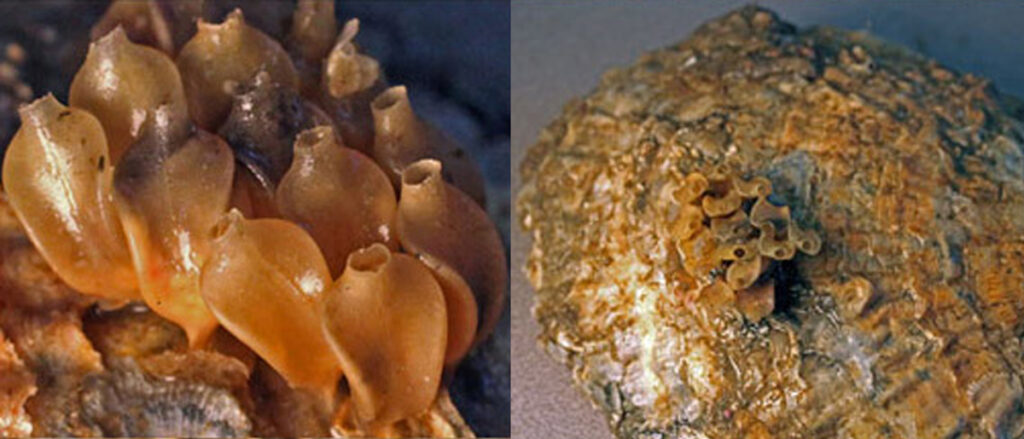
Japanese oyster drill
Ocinebrellus inornatus
Also known as: Asian oyster borer
What does it look like?
Snails with up to 5cm long, whelk like shells. These shells have irregularly formed costal and spiral ribs.
Distinguishing features
The shell of a Japanese oyster drill has thick irregularly formed spiral ribs and an aperture with a downward extension, which is missing in most similar native gastropods. The egg-capsules are also diagnostic for the species. They are flattened, slightly curved capsules of about 0.5-1 cm in length, with a rounded opening or closed tip on top of them.
Confusion with similar species
The shells of Ocinebrellus inornatus resemble those of common whelks (Buccinum undatum) and the European oyster drill Ocenebra erinaceus. The common whelk shells can easily be distinguished as they do not have a downward extension on the aperture. Ocenebra erinaceus shells are harder to differentiate from the shells of O. inornatus. In general O. inornatus have fewer spiral ridges (ribs positioned more or less horizontally on the whorl), i.e. 4-7 instead of the 8-9 spiral ridges on O. erinacea shells.
What is its origin?
Northwest Pacific
Habitat
The Japanese oyster drill prefers to lay its egg-capsules on oyster shells. As the larvae that come out of these egg-capsules do not have a pelagic phase they tend to settle nearby. Japanese oyster drill snails are therefore only found in habitats with Pacific oysters (Crassostrea gigas) and/or native oysters (Ostrea edulis). The egg-capsules are found most commonly on oyster shells in the lower intertidal and just underneath the low water line, in the subtidal.
Presence in Ireland
Not recorded on the Island of Ireland.
Behaviour and Spread
Japanese oyster drills mostly feed on oysters but can also feed on other bivalves including mussels and carpet shells. However, as they prefer to lay their egg-capsules on oyster shells they are usually only found in areas where oysters are present. They are restricted in their spread to these oyster areas as the individuals that hatch from these egg-capsules do not have a pelagic phase. They will therefore stay close to the area where they hatched. Missing a pelagic phase, this species will not spread far by natural dispersal. Oyster transports and/or the transport of oyster shells e.g. for habitat restoration, would be the most likely vector for introduction to and spread within Ireland.
Potential nuisance for aquaculture
Ocinebrellus inornatus is only known to have an impact on oyster fisheries/culture. Oyster nurseries and areas including oyster farms, with dense populations of relatively small oysters and oyster spat are particularly vulnerable. Japanese oyster drills are known to cause mortalities killing most of the oysters present. In more natural environments with a mixture of oysters from different ages, the impact of this species appears to be limited.
Key Management Actions
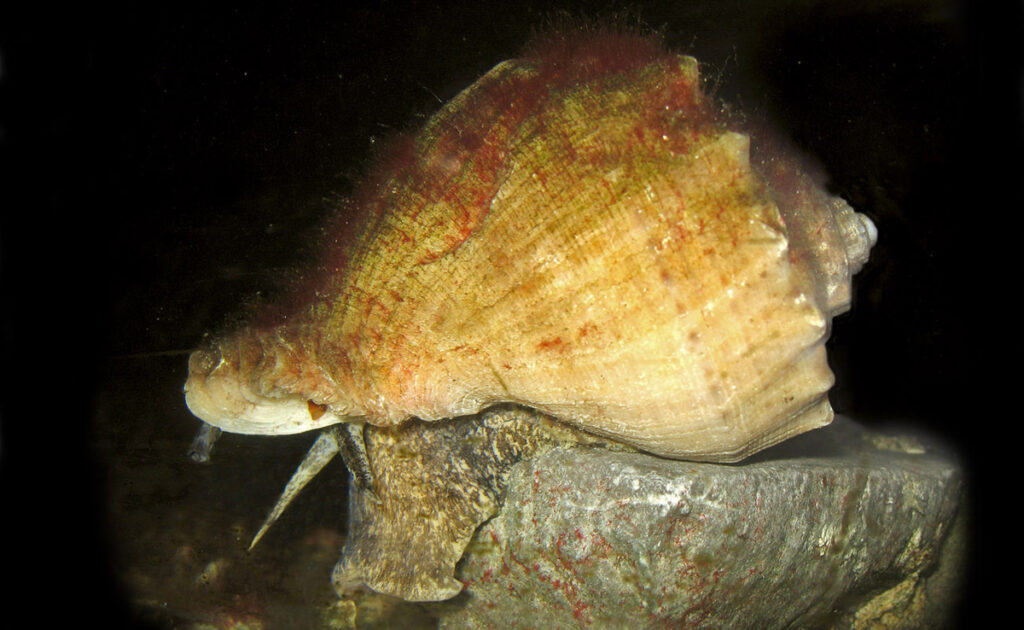
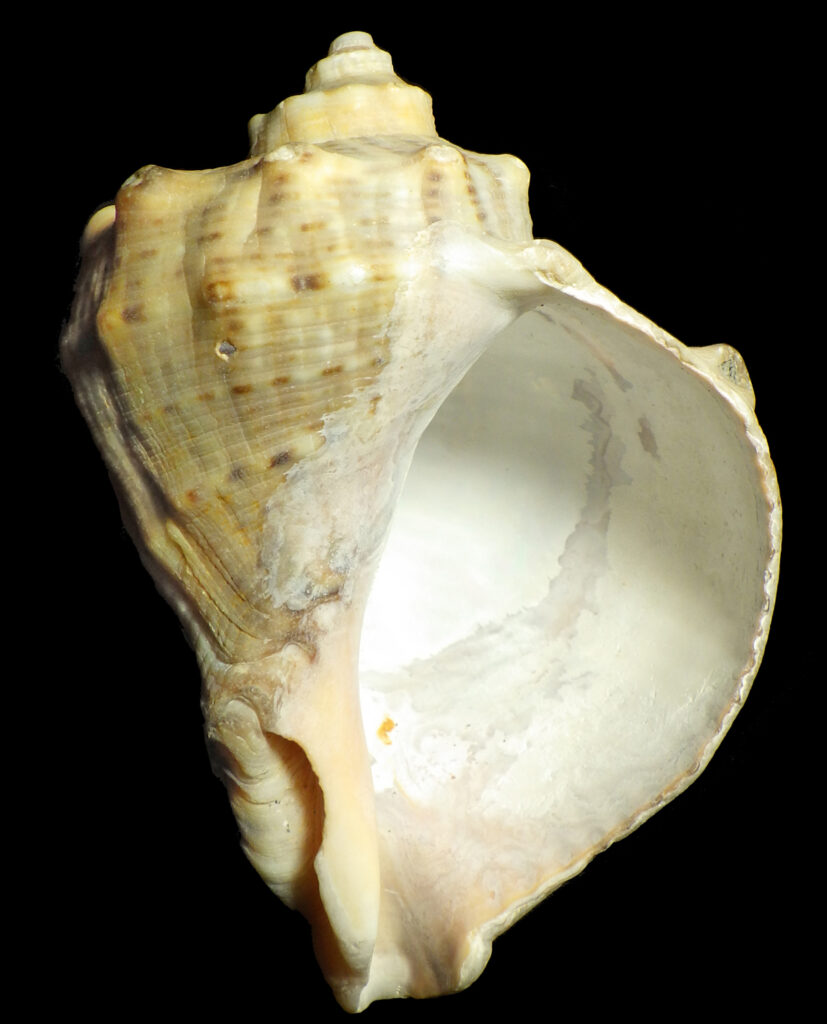
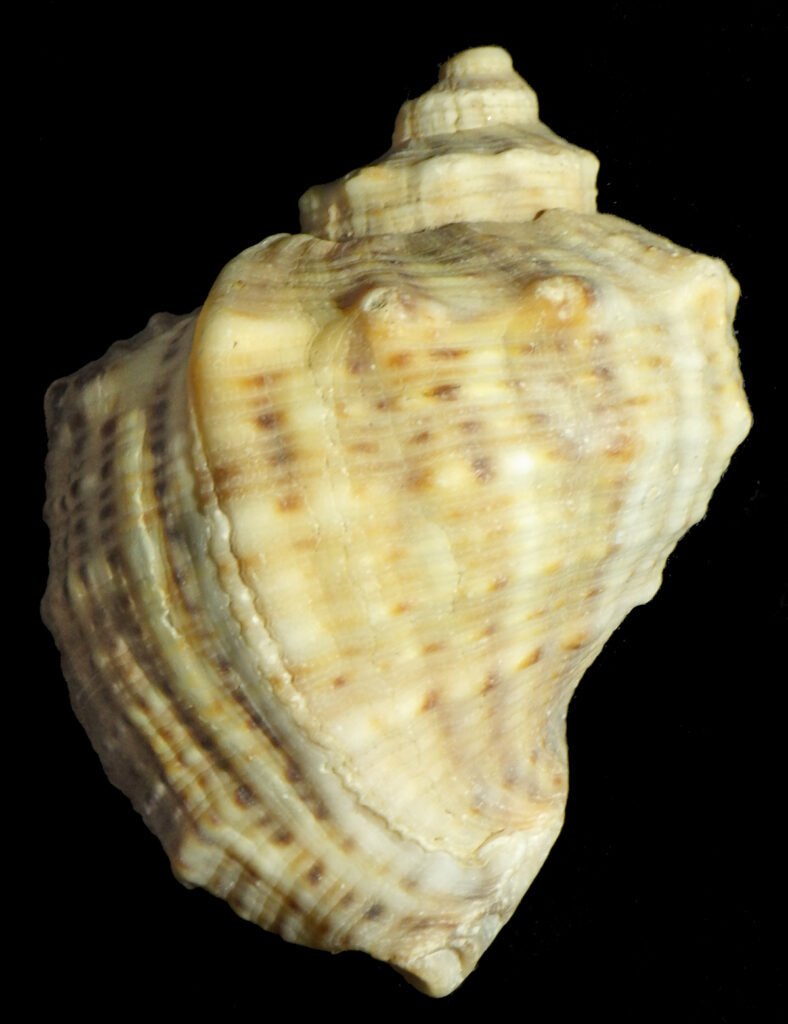
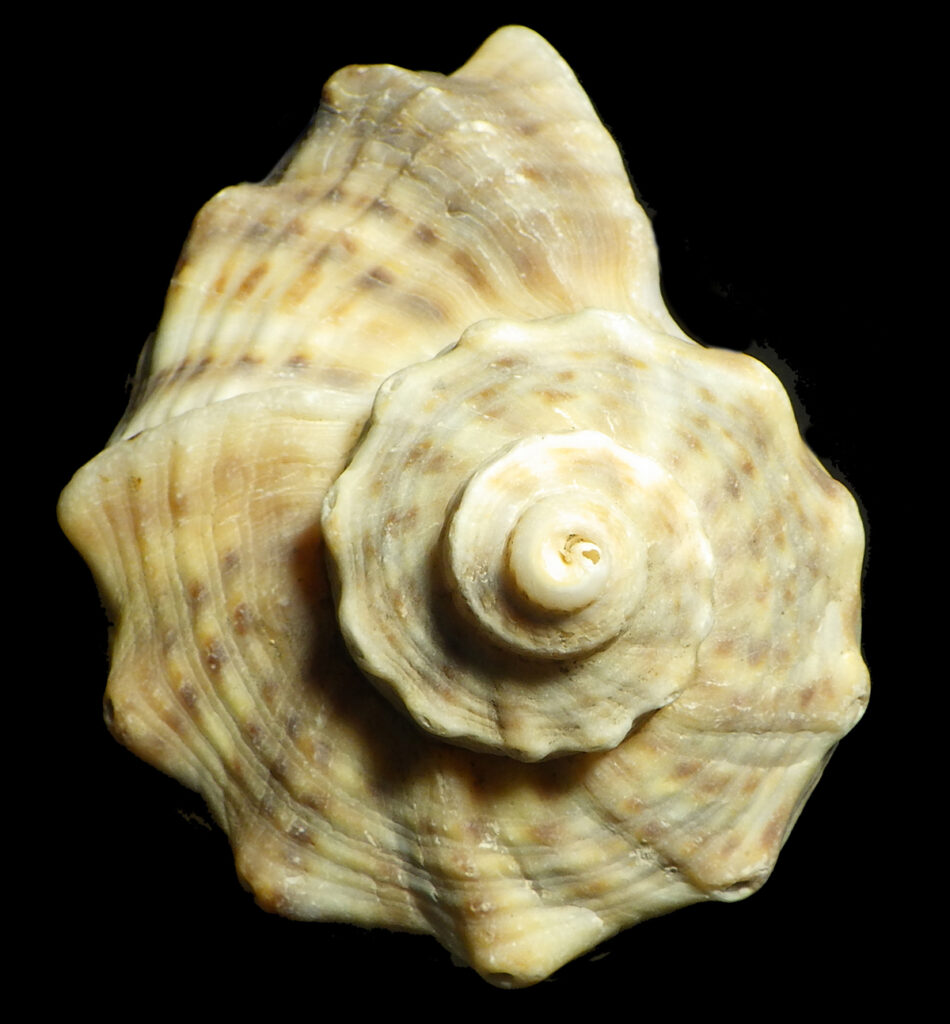
The veined whelk
Rapana venosa
Also known as: Asian Rapa whelk
What does it look like?
Similar to other species of whelk, Rapana venosa looks like a large snail. Its shell can be up to 18 cm in length with pointy projections on top of the whorls.
Distinguishing features
The large shells of the veined whelk Rapana venosa are easy to recognize as they have an aperture of about two thirds of the shell height with pointy projections on top of the whorls.
Confusion with similar species
The shells of Rapana venosa resemble those of the native whelk Buccinum undatum but can be distinguished by the pointy projections on top of the whorls, which the shells of B. undatum do not have. Another distinguishing feature concerns the relative height of the aperture, which is about half the shell height in B. undatum, and two thirds of the shell height in R. venosa.
What is its origin?
Northwest Pacific
Habitat
Rapana venosa can be found in temperate to sub-tropical waters, favouring sandy to hard substratum that supports bivalve populations upon which it can feed. It has been found in sheltered estuaries but is also recorded from exposed sites in open seas. Specimens of the species have been introduced repeatedly in western European waters with reports from Atlantic France up to the UK and the Netherlands. Although various Irish marine habitats, appear to be suitable for its settlement, R. venosa does not seem to have yet established populations in Western Europe. In similar habitats in, for example, north America and the Black Sea, the species has become established in high densities.
Presence in Ireland
Not recorded on the island of Ireland.
Behaviour and Spread
In spring to early summer females of Rapana venosa lay 30 mm long egg-capsules, and larvae hatch about two weeks later. After hatching the larvae remain in the water column drifting along with the currents for a further two weeks. It is assumed that R. venosa specimens are mainly spread in their larval stages within the ballast water of ships. Older individuals are assumed to have been dispersed mainly by aquaculture related transports, including transports of oyster seed.
Potential nuisance for aquaculture
When Rapana venosa establishes a population, local bivalve populations may go extinct because of this voracious bivalve predator. In addition to feeding on the “weaker” bivalve species, veined whelks may predate on oysters, and when most bivalves in a region are gone, it has been recorded that they will become cannibalistic, attacking their own kind. Although it is uncertain to what degree R. venosa would be able to establish a population in Irish waters, its potential impact on the shellfish industry (and the local ecosystem in general) calls for great care when Rapana specimens are suspected.
Key Management Actions

American oyster drill
Urosalpinx cinerea
Also known as: Atlantic oyster drill
What does it look like?
Snails with Dog whelk (Nucella lapillus) like shells up to 4.5 cm long. The shells have about 9-12 rounded, regularly formed costal ribs on each whorl, with numerous spiral cords.
Distinguishing features
The shell of an American oyster drill has distinct regularly formed costal ribs, numerous spiral cords and an aperture with a downward extension, which is missing in most similar native gastropods. The egg-capsules are also diagnostic. They are flattened, slightly curved capsules of about 0.5-1 cm in length with a rounded opening or closed tip on top of them.
Confusion with similar species
The shells of Urosalpinx cinerea resemble those of the native Dog whelk Nucella lapillus. They can be easily distinguished by the height of the aperture, which is about half the height of the shell in E. cinerea and about two thirds the height of the shell in N. lapillus.
Urosalpinx cinerea shells also those of the European oyster drill Ocenebra erinaceus and the Japanese oyster drill Ocinebrellus inornatus. The latter two oyster drill species have irregularly formed and placed costal ribs and spiral cords, while the ribs and cords on U. cinerea shells tend to be regular in shape and placed at regular distances to each other covering the complete whorl.
What is its origin?
Northwest Atlantic
Habitat
Urosalpinx cinerea snails appear to prefer lower intertidal and shallow subtidal habitats within estuaries. It is mainly found at sites that are sheltered from the main currents in relatively turbid waters with somewhat muddy bottoms.
Presence in Ireland
Not recorded on the island of Ireland.
Behaviour and Spread
American oyster drills predate on a large variety of marine animals varying from oysters and mussels to barnacles and bryozoans. The adults lay their egg-capsules on hard substrata preferring living oysters over dead shells. An American oyster drill can lay up to 96 egg-cases with about 11-12 eggs in each, depending partly on the size of the female. The juveniles that hatch from these egg-capsules do not have a pelagic phase and thus they will not disperse far. Oyster transports and/or the transport of oyster shells e.g. for habitat restoration, are therefore assumed to be the most likely manner with which this species could be introduced to and spread within Ireland.
Potential nuisance for aquaculture
In oyster nurseries and in areas (or on trestles) with dense populations of relatively small oysters and oyster spat, American oyster drills may cause mortalities killing a large proportion of the oysters present. Established populations in Europe are known to be very localized in, for example, Essex and within the Oosterschelde in the Netherlands.
Key Management Actions